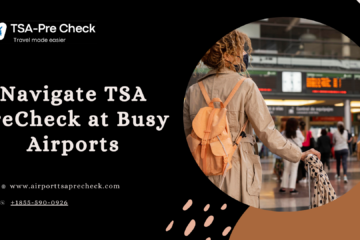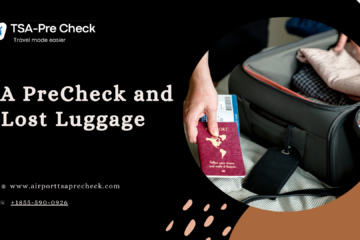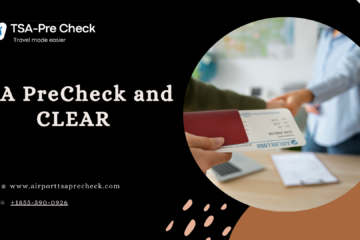Screening Procedures in TSA PreCheck are essential in aviation security. It involves a thorough check of every passenger and piece of luggage before boarding. Their role in aviation security is crucial to the extent that it cannot be overemphasized by the TSA. This is because it facilitates the prevention of potential threats and ensures a safe flying environment. Grasping the intricacies of these screening procedures is vital for travelers since it helps to prepare and reduce any possible inconvenience in the security check. This blog post covers all the crucial functions of the TSA, offers information on the different screening Procedures in TSA PreCheck, and provides advice on how travelers can pass through the security checkpoints!
Standard Screening Procedures in TSA PreCheck: A Comprehensive Guide
In the standard screening procedures in TSA PreCheck, the guidelines will outline the steps and other items that need to go through the screen; also, some tips on how to prepare for standard screening will be provided as well.
Steps Involved in the Screening Procedures in TSA PreCheck:
- The screening procedure starts with a few individuals/when individuals walk into the screening location. The regular procedure typically begins with security personnel greeting them and they are also being asked for identification and travel documents if needed. This first checkpoint governs only the authorized persons going to the next step.
- The people present their personal effects, like their carry-on bags or items, to the conveyor belt to be X-rayed while searching for X-ray scanning. The X-ray machine displays a well-defined image of the inventory. Thus, the guards can trace any risky or contraband items.
- Anyone experiencing a walk-through metal detector, where they are checked for metal objects, may be asked to remove any metal objects and have to go through it again if the detector alarms.
- Secondary Screening Procedures in TSA PreCheck are applied when an alert is triggered, or an item appears suspicious during the first check. This may consist of extra scanning, a physical check, or the employment of specialized equipment, e.g., explosive trace detectors.
- Your security force may need to pat a person down strictly, which is a comprehensive search by a security official of a private person’s body to determine whether contraband objects are being smuggled.
- After the final processes and the absence of disturbances are verified, all people can move on if they have no issues. They get their belongings back.
Items That Require Additional Screening
- Certain items sometimes need to go through secondary screening because of their possible risk or difficulty in identification among others as follows:
Large electronic items such as laptops and tablets could have to be taken out of the bags and put into the bins separately for screening purposes. - Liquids and gels are usually in limited quantities and a clear, resealable bag is required to place them in. Extra scrutiny or confiscation may occur if the submitted containers are larger than the standard size.
- Knives, scissors, and generally tools under tremendous scrutiny are usually left out and are not allowed in carry-on bags.
- Upon flying, prescribed medications need to be correctly identified, and there is even the possibility that the customer might be obliged to announce this in the security check process.
- If the item is out of the ordinary or cannot be easily recognized in an X-ray, the situation may require extended scrutiny.
How to Prepare for Standard Screening
You can make the screening process more efficient and less time-consuming with the right kind of preparation. There are some tips here that you can follow:
- It is advisable to have separate bags to screen the devices and the liquids, making it easier for the security officers to scan them.
- Make sure that you wear clothing and shoes that are easy to remove if necessary. Don’t try to wear too much jewelry or metal accessories that can set off the metal detector.
- Be sure you are well informed about the screening regulations of the place you are going to. Norms can be quite different, especially for distinct countries and visiting various facilities.
- Be gentle with yourself and allow sufficient time for security checks, especially during weekends and when the airport is full. This not only decreases your anxiety but also makes sure that you don’t overlook essential meetings or transfers while you are traveling.
- Stay informed about any revisions in screening procedures in TSA PreCheck or policies. Some airports and premises offer certain online resources for travelers and timely updates.
Proper procedure understanding and attention will help people who pass the screening to be efficient and with no stress. In this way, all the members will feel safe and protected.
Tips for Smooth Screening Procedures in TSA PreCheck
Security at airports is complex and confusing. Nevertheless, if you follow some simple tips, the screening process will be a smooth one. This guide deals with ideas mainly packing light and efficiently, arriving at the airport early, understanding TSA regulations, and utilizing TSA’s website and mobile app that are also relevant to the school.
Packing Light and Efficiently
- Only take the things you need. Overpacking will not only make your luggage lighter and easier to carry around but also speed up the screening process and decrease the probability of getting security alerts.
- On top of your bag arrange the things you intend to take out. Things like Electronics, liquids, and others should be easily accessible for inspection.
- Put all your liquids, gels, and aerosols in containers of 3.4 ounces (100 milliliters) or less, and they should fit in a one quart-sized, see-through, zip-locked plastic bag. No delays through security are the result of this rule shortens your waiting time.
Arriving at the Airport Early
- Avoid getting to the airport later than two hours before a flight and for international flights be at least three hours earlier compared to the departure time. In this case, you get to go through the security check and check-in, and if there are any other delays you have enough time before departure.
- Keep track of the peak travel periods and ventilate your schedule around these. It is common to see airports flooded with people during certain holidays and weekends, especially so, it is advisable to allocate that extra time to them.
- When going to the airport, make sure to look up the current status of your flight to have up-to-date information about the possibility of delays or alternations. This is quite crucial if there is any unexpected fluctuation in your flight schedule.
Understanding TSA PreCheck Regulations
- Before your trip, please familiarize yourself with the TSA regulations. Being aware of what you can and cannot carry through security creates an opportunity to pack wisely and spare yourself unwanted inconveniences.
- Always remember the objects that are not allowed in both the hand luggage and the compartment in the plane. Some of these are cutting tools, types of substances that can easily catch fire, and different sports gear.
- You should have your ID and boarding pass handy at all times. By doing so, you can pass through the check-in and screening without hassle.
Utilizing TSA’s Website and Mobile App
- The TSA website is a rich source of information, offering a list of banned items, thorough screening procedures, and travel advice. The website regularly changes its security protocols, and the whole process is made easier if you stay updated.
- Get the TSA mobile app for quick access to helpful resources. Features this app provides such as wait times for security checkpoints, flight status updates, and the ability to ask specific travel questions come in very handy.
- Check the wait times and delayed flights through the My TSA application, schedule your arrival, and manage the airport easily.
- To let travel alerts TSA have notifications coming to you for the changes in security procedures or for other things that are important for the journey you can register for them. When you are aware of any changes, you can plan better and make changes in time.
One can lessen the anxiety and difficulty of airport security screening substantially by using these guidelines. Smart packing, going early, knowing the TSA rules, and availing the resources available will result in a much better and quicker travel experience.
Conclusion:
To sum up, clear knowledge about the screening procedures in TSA PreCheck is vital for a pleasant traveling experience. Being able to access security, among other things, by merely packing well and cooperating with the people in charge, is how you can get through the airport checkpoint smoothly. Just keep in mind that the rules are for everyone’s safety, so therefore, waiting and obeying is the first thing that comes to your mind. Be sure to always check the TSA website for the latest information!
FAQs
Q. How do I prepare for TSA PreCheck screening?
Ans. Be efficient with your packing, making sure liquids and electronics are easily accessible, and get to the airport early with the documents you need right from the start. Study the TSA guidelines and download their app to watch for changes.
Q. What is the screening system in the airport?
Ans. At the time of screening, you will be identified utilizing a body scanner or a walk-through metal detector instrument.
Q. What is second screening with TSA PreCheck?
Ans. Secondary screening carried out by TSA includes extra checks added to the first screening one. This can be through the extensive examination of luggage, the use of a pat-down, or a piece of specialized equipment that can help to locate a suspicious object or to address security issues.
Q. What happens during TSA PreCheck screening?
Ans. At the TSA PreCheck security screening, passengers use a particular fast lane where they can leave their shoes, belts, and light jackets on, and do not have to take laptops and compliant liquids out of their bags, thus shortening the process and making it more comfortable.
Q. What is TSA screening?
Ans. TSA employs screening procedures at airports to guarantee the well-being of travelers and planes. Examining travelers and their possessions with the use of X-ray equipment, metal detectors, and pat-downs is part of the process.



0 Comments